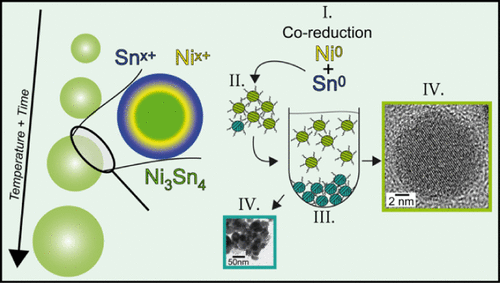Our official English website, www.x-mol.net, welcomes your feedback! (Note: you will need to create a separate account there.)
Detailed Characterization of the Surface and Growth Mechanism of Monodisperse Ni3Sn4 Nanoparticles
ACS Omega ( IF 4.1 ) Pub Date : 2018-12-10 00:00:00 , DOI: 10.1021/acsomega.8b02597 Anke Düttmann 1 , Christian Gutsche 1 , Martin Knipper 1 , Jürgen Parisi 1 , Joanna Kolny-Olesiak 1
ACS Omega ( IF 4.1 ) Pub Date : 2018-12-10 00:00:00 , DOI: 10.1021/acsomega.8b02597 Anke Düttmann 1 , Christian Gutsche 1 , Martin Knipper 1 , Jürgen Parisi 1 , Joanna Kolny-Olesiak 1
Affiliation

|
Synthesis of most tin-based bimetallic nanoparticles is a challenging task because of the differences in the redox potential and the melting point between both components. This article presents a co-reduction synthesis of monoclinic Ni3Sn4 nanoparticles. Varying time and temperature gives the possibility to control the size of the nanoparticles in the range of 4–12 nm. The products were characterized by X-ray diffraction, high-resolution transmission electron microscopy, X-ray photoelectron spectroscopy, and energy-dispersive X-ray spectroscopy measurements. Although the synthesis was conducted entirely oxygen free, the postsynthetic treatment undertaken under air leads to the formation of an amorphous oxide shell. The oxide shell consists of an outer tin-rich region and a nickel-rich region at the interface to the metallic Ni3Sn4 core. On the basis of the investigation of the particles at different stages of the synthesis, we propose a growth mechanism for the Ni3Sn4 nanocrystals. These results can be a guidepost for the synthesis of other tin-based bimetallic nanoparticles.
中文翻译:

Ni 3 Sn 4单分散纳米颗粒的表面特征及其生长机理
由于两种组分之间氧化还原电势和熔点的差异,大多数锡基双金属纳米颗粒的合成是一项艰巨的任务。本文提出了单斜晶Ni 3 Sn 4的共还原合成纳米粒子。时间和温度的变化使将纳米粒子的尺寸控制在4–12 nm范围内成为可能。产品通过X射线衍射,高分辨率透射电子显微镜,X射线光电子能谱和能量色散X射线能谱测量进行了表征。尽管合成是完全无氧的,但在空气中进行的后合成处理导致形成无定形氧化物壳。氧化物壳在与金属Ni 3 Sn 4核的界面处由外部富锡区域和富镍区域组成。在对合成不同阶段的颗粒进行研究的基础上,我们提出了Ni 3 Sn 4的生长机理。纳米晶体。这些结果可以作为合成其他锡基双金属纳米粒子的指南。
更新日期:2018-12-10
中文翻译:

Ni 3 Sn 4单分散纳米颗粒的表面特征及其生长机理
由于两种组分之间氧化还原电势和熔点的差异,大多数锡基双金属纳米颗粒的合成是一项艰巨的任务。本文提出了单斜晶Ni 3 Sn 4的共还原合成纳米粒子。时间和温度的变化使将纳米粒子的尺寸控制在4–12 nm范围内成为可能。产品通过X射线衍射,高分辨率透射电子显微镜,X射线光电子能谱和能量色散X射线能谱测量进行了表征。尽管合成是完全无氧的,但在空气中进行的后合成处理导致形成无定形氧化物壳。氧化物壳在与金属Ni 3 Sn 4核的界面处由外部富锡区域和富镍区域组成。在对合成不同阶段的颗粒进行研究的基础上,我们提出了Ni 3 Sn 4的生长机理。纳米晶体。这些结果可以作为合成其他锡基双金属纳米粒子的指南。


























 京公网安备 11010802027423号
京公网安备 11010802027423号